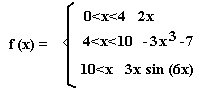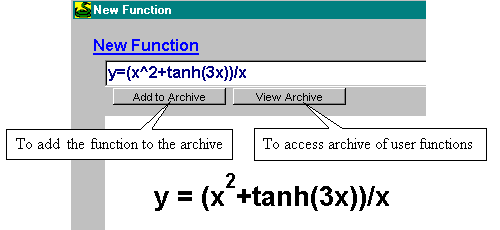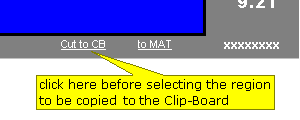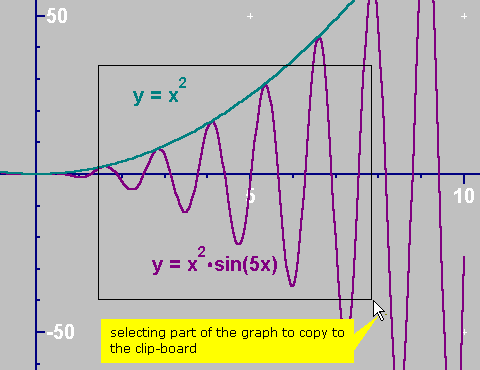|
| |||||||||||||||||||||||||||||||||||||||||||||||||||||||||||||||||||||
|
|
What is ASP? ASP, Algebraic Scratch Pad, is Microsoft Windows software designed as a two-dimensional graphic aid for mathematical and engineering applications. ASP's extremely simple Windows ® interface facilitates the two-dimensional graphing of individual points and/or explicit functions of a single variable.
The installation is handled entirely by the installer utility which comes with the
distribution. The installer ("Install.exe") runs automatically once the CD is placed
in the CD drive. If the AutoRun has been disabled / not enabled, the installer can be accessed through:
The installer creates a desktop icon to facilitate later use of the program.
The control panel, which is shown in a vertical
band on the right hand side of ASP's main
screen, has the basic access to the different features and functions.
The buttons in the control panel include:
ASP's Usage:
Click on New Func to access the window where the function will be typed. The window shows
two fields. In the upper one the user types the expression. The program's interpretation
of the typed expression is shown simultaneously in the lower field. The expression shown
in the lower field will accompany the trace of the function on the graphics screen.
The user can drag it around to place it in any convenient screen location. The typing of
the new function should start with y=....(explicit function of x). The user types: y=e^(-sin(3x+7))+2x^2-6x . When finished typing, the key "Enter"
should be pressed or the button Done should be clicked. To enter the function The user types: y=(ln(5x^3-2)+4/(x+2))^(3/2) . When finished typing, the key
"Enter" should be pressed
or the button Done should be clicked.
Click on New Func to access the window where the function will be typed. In the upper field the user types the expression. By the use of the keys: {, }, <, : and ; , the user specifies:
Example: To enter the function:  The user types: y={0<x<4:2x;4<x<10:-3x^3-7;10<x:3x*sin(6x)} .
When finished typing, the key "Enter" should be pressed
or the button Done should be clicked. The symbols used in this expression mean: 
The user can retrieve from memory any of the functions that he or she has typed and graphed
previously. This saves typing effort when creating a new function, for which just a few
terms or parameters are different from a previously typed one. After pressing
New Func, to
start a new entry, by clicking on the up and down arrows of the keyboard, the user scrolls
over all the textual expressions of the functions previously entered. The text is
automatically entered in the upper and lower fields of the New Func window, ready for
editting or direct graphing.
By clicking on Extra Data in the control panel, the user accesses a window that
allows him/her to enter the individual points one by one, or to load a file with the data
information. Individual data is entered on the top field of the window. A carriage return
(Enter key) is required to end the data entry. The size, color and symbol to be used for
the data can be specified on the same line if the user wants different options from the
ones given by default. Default values are: size = 1, symbol = + and
color specification
the ones defined by the user from the color palette for the functions but in inverted
order.
on the top field of the window and ending each line by pressing the Enter key or clicking on the Add button on the upper right of the field. By this action the data is transferred to the lower field and accumulated there until the user clicks on Done to have the points plotted on the screen.
Instead of entering the data one by one with the plotxy option, the user can create a file
with just the pairs (x,y) that need to be plotted and invoke the file from the Extra
Data window.
The user types: plotxyfile mydata.txt color 2 size 4 symbol o finishing with a carriage return (Enter key) or by clicking on the Add button on the upper corner of the top field. The line is transferred to the bottom field, and the user clicks on Done to have the data drawn on the screen.The pairs (x,y) will be plotted on the screen, with o as the symbol on size 4, and all points with the color set from the palette for function # 2. By typing joinxyfile mydata.txt (option joinxyfile instead of plotxyfile), and proceeding as described in the paragraph above, lines will be drawn joining the data points in the order they appear in the specified file. While in the Extra Data window, the user can select individual lines (by clicking on them in the lower field), and edit them ( by clicking on the Edit button) to introduce modifications.
The user selects the function by right mouse button clicking on its explicit expression (this highlights one of the function's parameters). The user clicks on the appropriate control panel button for the desired operation. 

The user may want to use graphics produced by ASP as pictures by themselves, or as ilustrations in text documents. ASP allows to select a portion of the graphic screen determined by the user, and to copy it to the "clip-board". The image copied is handled like a bitmap image, and can be used with several Windows'® utilities like "Paint", "Word-Pad", "Word", "Imaging."  The process is very simple, and starts by left mouse button clicking on the title "Cut to CB" (Cut to Clip-Board) at the botton right of the graphic screen. Once this title is highlited, the user defines the area (rectangle) to be copied by pressing the right mouse button at one of the corners of the region of interest and dragging the mouse while holding the button down until the rectangular section has been defined. At the release of the right mouse button, the selected area is copied to the Clip-Board, and the highlighting on the title "Copy to CB" would have disappeared.  The utility for matrix operations and methods, can be accessed by clicking on the title "to MAT" at the botton right of ASP's main screen.  |
